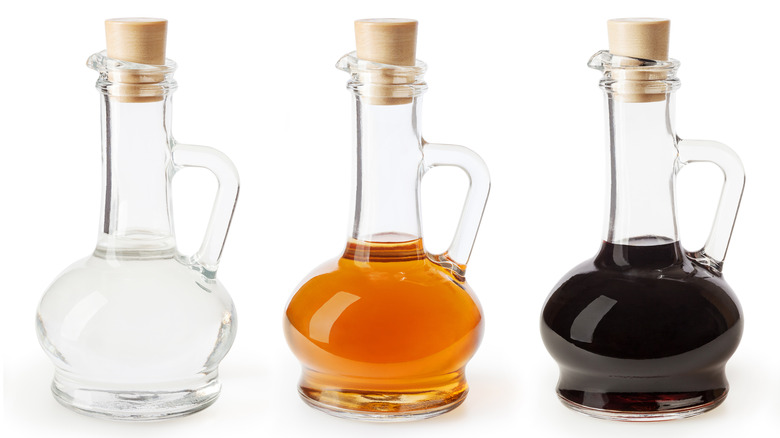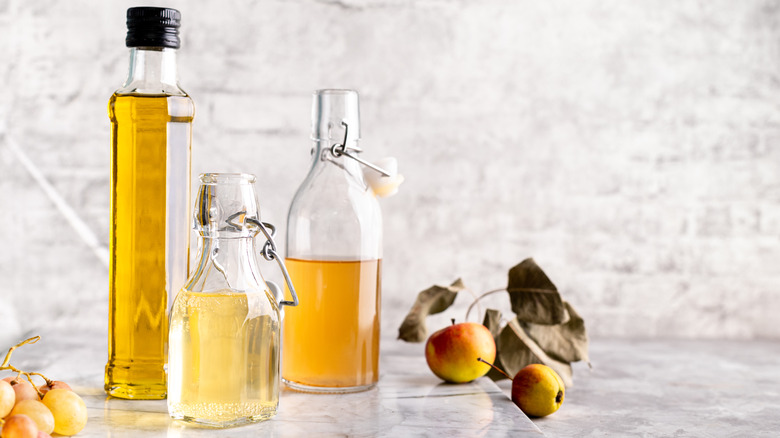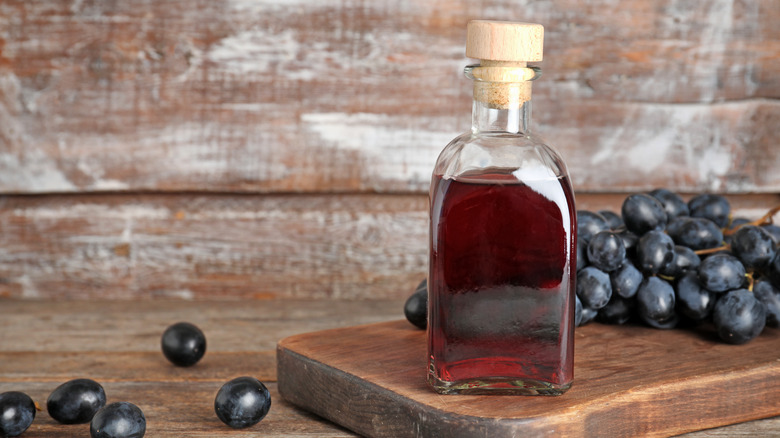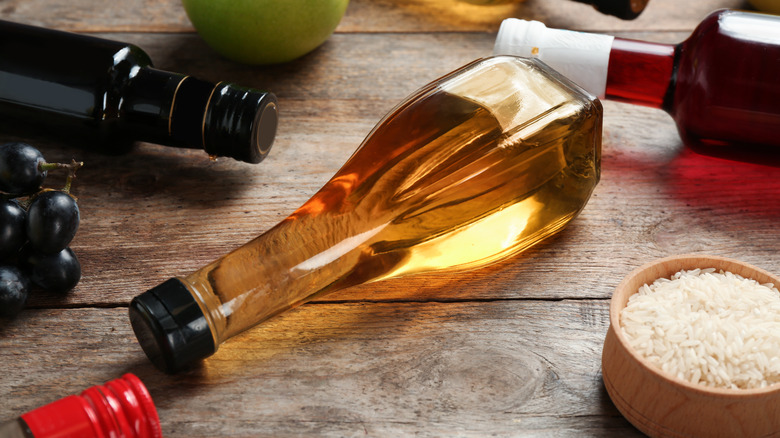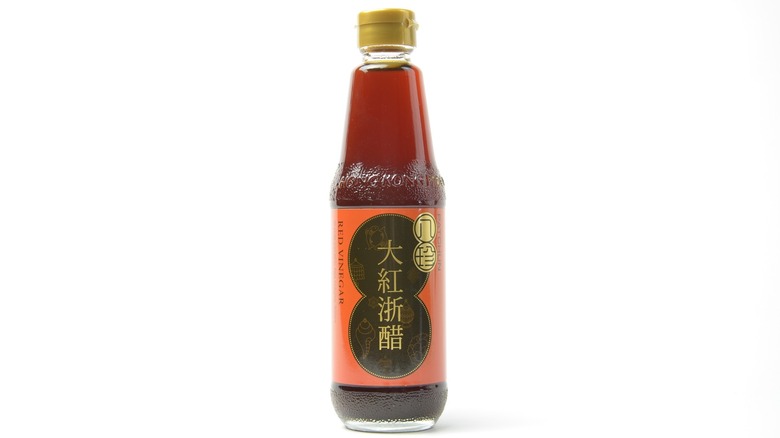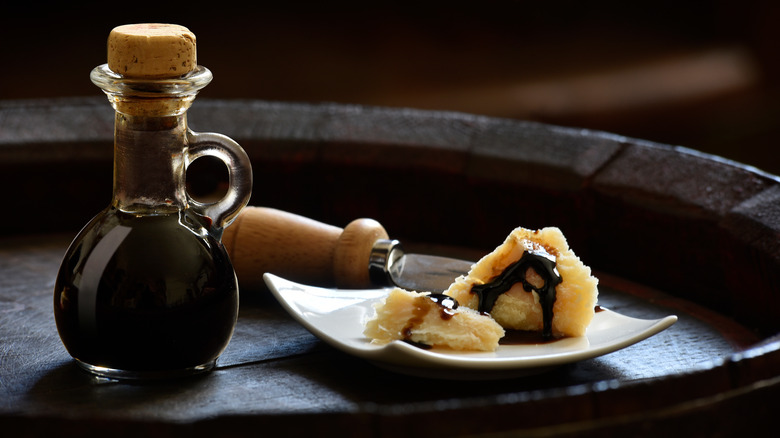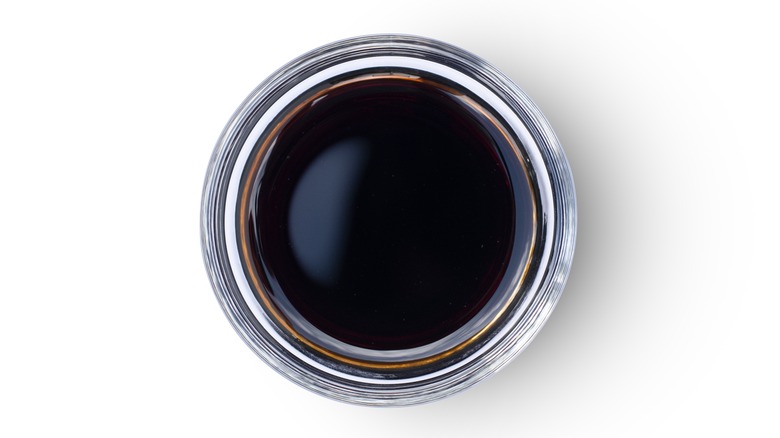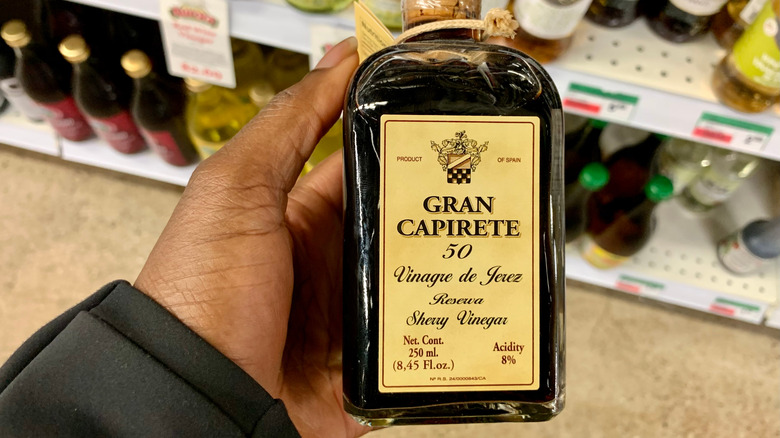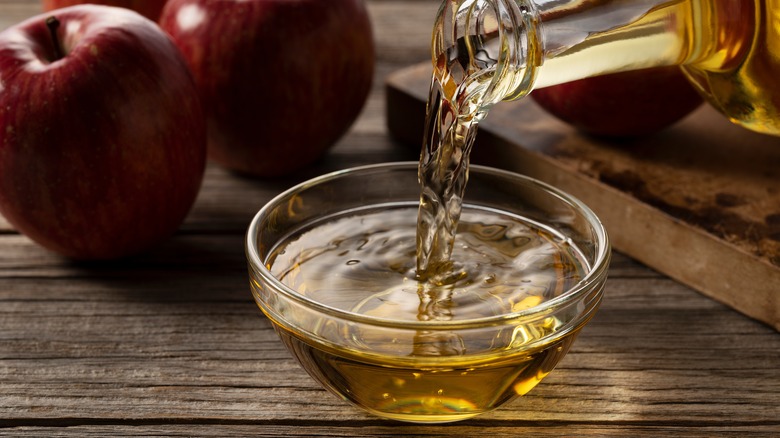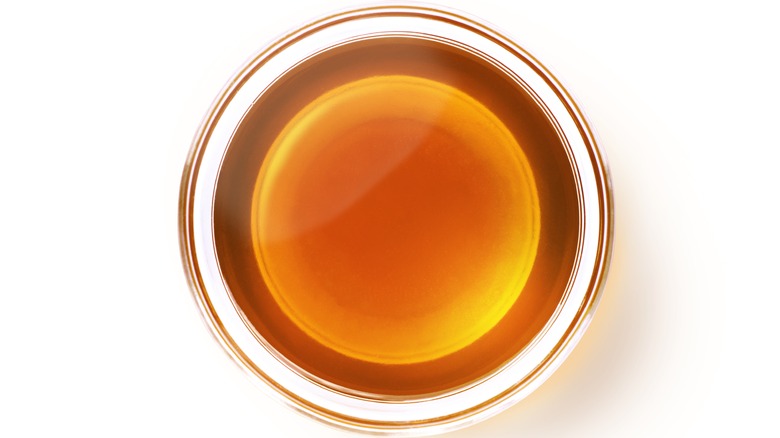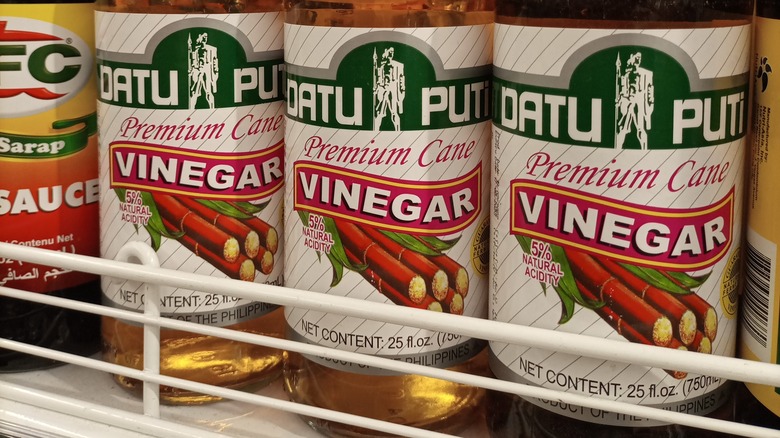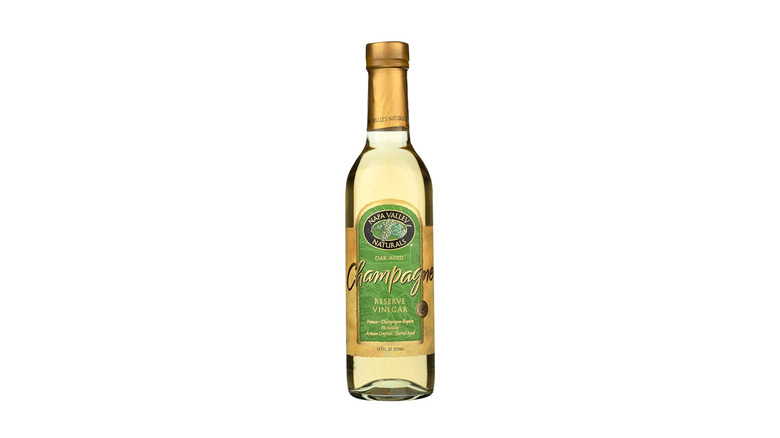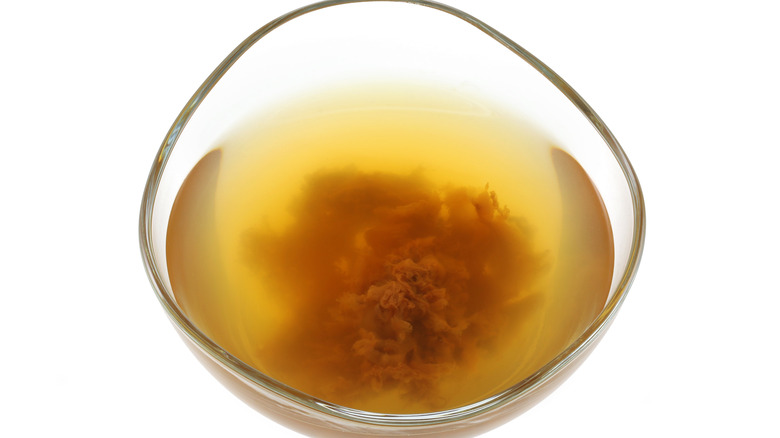14 Tips You Need When Cooking With Vinegar
Vinegar is a happy mistake turned staple culinary ingredient that holds the distinct honor of being the oldest fermented ingredient in all of history. In fact, Babylonian scrolls dating back to 5000 B.C.E. even detail its use. Alone, vinegar is acidic, stringent, and less than desirable to unacquired palates. Yet when combined with other ingredients, it has a way of highlighting and elevating a flavor's profile. That said, due to its strong flavor, vinegar can easily overpower dishes, which means it must be used with discretion. You can give a zingy punch to collard greens or add an extra layer of pizzazz to savory sauces — just so long as you don't overuse it. Vinegar is also great for pickling a wide selection of veggies, giving your dishes a flare of flavorful garnish.
There are many different types of vinegar. From sweet to nutty, along with fruity to peppery, there's endless room for exploration. Depending on your taste for acidity or whether you prefer sweet to salty, you may favor a certain type over another. Beyond food, vinegar also has medicinal, agricultural, horticultural, and cleaning capabilities. It might just be one of the most useful discoveries ever. With so many types, flavors, and acidity levels, knowing which vinegar to use for a particular recipe can mean the difference between a satisfying meal and a bad one. Below is a list of tips to help you fully experience the benefits of cooking with vinegar.
Use white wine vinegar for basic vinaigrettes
A common type of vinegar you'll find on grocery store shelves is white wine vinegar. Not to be confused with white vinegar, which is made from water and acetic acid, white wine vinegar comes from fermenting wine. Its sour accent is an awesome compliment for meats, sauces, and marinades. More acidic than many other varieties, its pronounced kick can be used to kill it in the kitchen or front yard weeds.
Affordable and versatile, white wine vinegar happens to be the star of many sauces like sweet and tangy beurre blanc, buttery Hollandaise, and tarragon-sprinkled béarnaise. Saying it's useful is an understatement; trust us, your summer BBQs wouldn't be the same without vinegar's vibrant touch. While made from wine, you needn't worry about any intoxicating effect, as all the alcohol is burned away during the fermentation process. Simply put, white wine vinegar is one of those staple ingredients you should always keep a supply of.
Red wine vinegar adds robust flavor to red meats
As you might imagine, if there's white wine vinegar, there has to be one made from red wine, right? Red wine vinegar is very similar to its white compadre in acidity, yet of course, carries the flavor and color of red wine. This makes it interchangeable in recipes that call for white wine vinegar unless you prefer a particular grape flavor. Its bold and fruity touch pairs excellently with red meats, salad dressing, and other full-flavored foods. Like wine, the grape type used and fermenting process can impact the quality of the vinegar.
That's why determining the variety of grapes used is a great indicator of high-quality wine vinegar. If you have a penchant for wine, you may prefer a cabernet to a shiraz or a merlot to a zinfandel. You can carry your preferences over to wine vinegar, too, as it typically features its origin grape on the label. Whether red or white, the same rules apply. If you have trouble finding it, odds are it was created from a blend of grapes. As always, the higher the quality, the more flavor complexity.
Rice wine vinegar is a refreshing kick for Japanese dishes
In countries around the world, people have put their own spin on vinegar, giving a zesty twist to all sorts of dishes. In Japan, you'll find rice wine vinegar, also referred to as simply rice vinegar. It's available in white and brown rice varieties and has a yellow to brownish hue, respectively. Unlike white wine vinegar, it contains less acidity while carrying a delicate and sweet flavor. Between the two vinegar options, white rice is more popular in Japan and is a common ingredient for marinades, sushi rice, and oshinko.
Although it has the word "wine" in it, similar to how wine vinegars are fermented from actual wine, rice wine vinegar begins as rice before being fermented into sake, then finally fermented into vinegar. Identical looks aside, Japanese rice vinegar is noticeably distinct from white wine vinegar, which means they aren't interchangeable ingredients.
Red rice vinegar gives Chinese cuisine a touch of tart
Also hailing from the Eastern hemisphere is China's red rice vinegar. It's made from fermented red yeast rice and is one of three main types of rice vinegar used in Chinese cuisine: white rice vinegar, red rice vinegar, and black rice vinegar (or Chinkiang Vinegar). Of the three, it's the least used. Carrying a milder acidity in comparison to distilled white vinegar, it's the perfect compliment for dipping sauces, seafood dishes, and soups too.
It's dark reddish in color and has a sweet and tart taste. Due to its lower level of acidity, red rice vinegar is a good substitute for wine varieties, which have a similar kick. If you add some sugar, it can also be used as an alternative to black rice vinegar, another of China's three main types. Some versions are even sweetened or flavored and are used to spruce up cocktails. Whether for cooking or a delicious drizzle, red rice vinegar is a culinary complement.
Reduce store-bought balsamic vinegar for extra flavor
A popular type of vinegar you've most likely tried on many occasions is balsamic vinegar. Although it's been around for thousands of years, it was only available in certain regions across Italy for most of that time, making its way to America in the 1970s. Its stateside introduction via Williams-Sonoma sent a shockwave through the culinary scene and is now commonly used in a wide assortment of recipes.
Balsamic vinegar's versatile flavor can be used in everything from dressings to cocktails. Its strict creation process makes balsamic vinegar different from other vinegars. To put it lightly, it's complicated. Not only will you need to follow specific steps, you'll also need 10 years, along with serious patience. In fact, traditional balsamic vinegar requires so much work there's a good chance you've never actually had an authentic kind. You can easily break the bank and spend hundreds for a quality one that was made in the traditional method.
Fortunately, since many of us don't have the extra moolah to purchase the top-shelf stuff, there's an easy trick for making cheap balsamic vinegar taste expensive. A reduction will give your everyday store-bought brand a delicious boost. All you have to do is add a bit of sugar and port, turn the heat on, and let the magic happen. When finished, the reduction should give your balsamic vinegar a velvety, syrupy consistency that's concentrated with flavor.
Black vinegar's flavor depends on its origin
Another of China's main varieties, black vinegar, is the dumpling dipper of your dreams. What makes black vinegar unique is that it comes from fermenting steamed grains. The process generally takes place over the course of six months, although it can be extended for years until the flavor is deep and rich. During it, the vinegar experiences the Maillard reaction, which is when sugars react with amino acids to form complex compounds. It's what causes the brown pigment in cooked meats and beverages.
You'll find four regional varieties of black vinegar in China: Shanxi province's sorghum, wheat, or barley-made vinegar, the city of Zhenjiang's sticky rice kind, Sichuan province's heavily seasoned multi-grain based type, and lastly, Fujian province's fungi-infused rice vinegar. Even outside of China, unique varieties can be found in Japan, Korea, and Taiwan, each offering its very own flavorful experience. With an unmistakable black color, unlike white vinegar, its flavor profile includes aromatic notes like licorice and an earth-like maltiness. It's also less acidic, giving it a similar quality as balsamic vinegar.
Enjoy your summer gazpacho with sherry vinegar
Your summer will be a lot brighter with the underrated vinegar we recommend keeping in your pantry. Originating from Southern Spain, sherry vinegar comes from the same place as...you guessed it, sherry wine. Strict guidelines must be followed in order for it to be considered authentic; only certain grapes can be used, and it has to be grown in a specific place and undergoes a particular aging method. There are three types of sherry grapes, which all can be used to make vinegar.
Sherry vinegar has a subtly sweet and milder taste, accented by delicious nuttiness. Drizzle some drops into your favorite vinaigrette seafood dish, along with a wide selection of recipes. Take it from Michelin-starred chef José Andrés, who says it's the vinegar of choice for super flavorful gazpacho. It elevates the overall flavor, making its ingredients of peppers, cucumbers, tomatoes, garlic, olive oil, and oloroso sherry more pronounced. Your pantry will be better equipped with sherry vinegar on the shelf.
Replace eggs with apple cider vinegar for extra lift
Despite its piquant quality, vinegar's wide-reaching abilities are even useful in baking. Take apple cider vinegar, for example, which is commonly used in vegan baking to replace eggs. Rather than providing flavor, it's used because it adds extra lift by providing acid. When combined with baking soda, the subsequent chemical reaction creates carbon dioxide, which forms little bubbles, helping it to rise more. Whereas traditionally, you'd get the extra aeration from good ol' beaten eggs.
You might be surprised that some of your favorite vegan treats have apple cider vinegar in them. From soft and fluffy pancakes to chewy and chocolatey cookies, it's the secret ingredient that saves the day. You'll only use enough for added crumb, but not so much to where apple cider vinegar's sour zing slips through. After you pour some into your batter mixture, let it sit for a few minutes to allow time for the vinegar to react. When you see the bubbles begin forming, you'll know it's ready. Try this tip out next time you bake; you might find your hand in the cookie jar more than usual.
Malt vinegar pairs perfectly with fish and chips
In the U.K., and wharves throughout the western hemisphere, malt vinegar is the preferred comfort food pick. It's most often served with traditional fish and chips, adding its signature tingle of sour and savory. Made with malted barley, the same grains that are used to produce ale, malt vinegar carries a similar taste of caramel nuttiness, along with a citrusy tinge. In fact, it's actually made into an ale during the fermenting process before becoming vinegar.
That, of course, makes it pub-friendly, where fish and chips are a common menu fixture. If pubs aren't your cup of tea, making delicious fish and chips at home takes less than an hour. Most varieties of malt vinegar you'll find will have some shade of brown, yet there are distilled versions that are sold clear. In addition to crave-worthy fish and chips, we definitely recommend keeping malt vinegar on drizzle duty; it goes great with salads and red meats.
Explore an array of flavors with beer vinegars
Malted vinegar isn't the only pub-friendly option on the block, some vinegars are actually produced directly from finished beers. You can literally create vinegar using one of your favorite beer brands, which means that there are endless flavors to experience. A vinegar produced from a Duvel will take you on a completely different adventure than one from Sapporo. Along with a wide range of flavor possibilities, beer vinegar is surprisingly simple to make too.
To make homemade beer vinegar, you'll need something called mother of vinegar, also known as a vinegar mother. It's a layer of film that naturally forms on the surface during the fermenting process when the container is left uncovered. Due to oxygen exposure, bacteria feeds on the alcohol that's produced, thereby turning it into a gelatinous film that's composed of acetic acid, which is the science-y name for vinegar. With your mother of vinegar on hand, all you have to do is combine it with the beer of your choice, cover the contents with a towel, and for one to two months, allow it to ferment in a dark and warm space.
Cane vinegar offers a taste of Filipino tradition
Fermented from sugarcane, cane vinegar is a common staple of Filipino cuisine and in countries across Asia. Its mild flavor is comparable to rice vinegar, yet can vary depending on the fermentation process. More bitter than sweet, cane sugar is perfect for giving ingredients some pickled pizzazz and blending into delicious sauces. In the Philippines, there are two main types: sukang maasim (white cane vinegar) and sukang Iloco, which comes from a sugarcane alcoholic drink called basi.
While common to traditional Filipino food, it's generally available in the U.S too. Pickle some seasonal veggies with white cane vinegar, or add a refreshing accent to chicken adobo's salty profile with the sukang Iloco, which is made from sugarcane wine. Beyond Filipino cuisine, it's also produced in Louisana, where locals use it in Cajun and Creole recipes. If you're looking for a milder option, cane vinegar is definitely the way to go.
For a low acidic option, use champagne vinegar
From wines to beers, it's clear that vinegar and alcohol have a lot in common. This next type of vinegar carries a fancy name yet is widely available at most grocery stores. Called Champagne vinegar; we don't need to tell you what it's made from, do we? It's light in color, like the bubbly beverage it comes from. On a scale of soft sting to brash and burning, Champagne vinegar has a milder taste which makes it great for topping meals with.
Similar to how authentic Champagne must originate from the country it's named after, only chardonnay and pinot noir grapes can be used to make this vinegar. The grapes bring a fruity touch to the party, balanced by woodsy notes that develop from the oak barrel-aging process. Use it as a light salad dressing or mix a bit into tomato or hollandaise sauce. It's also a good substitute for malt vinegar.
Use vinegar mother to boost your immune system
As previously mentioned, a vinegar mother is a layer of film that is produced during the fermenting process as bacteria consume alcohol, turning it into acetic acid. It's less common to come across them, as distilled vinegar removes it from the liquid. Yet, if you dove into the world of vinegar, you've most likely used raw vinegar before and noticed the gelatinous mass.
Admittedly, the idea of a colony of woven bacteria cellulose doesn't sound the most appetizing, yet gooey-gobs aside, vinegar mothers have amazing immune-supporting benefits. The bacteria is actually friendly and have tiny smiles when looked at under a microscope. Ok, I made that part up. What is true, though, is that vinegar mothers are great for maintaining digestive health and boosting overall immunity. It's fairly easy to make too. You can even take a piece from store-bought raw vinegar and add it to an alcoholic beverage.
Refrigerate low acidic vinegars to extend shelf life
One of the best qualities about vinegar is its shelf life. Unopened, many vinegars can last years. If they're stored in a pantry or cabinet away from direct light contact, you can enjoy them for many years more. This is only true for highly acidic vinegar types, which are strong enough to retain their punch against the passing of time. For lower acidic types that are more susceptible to exposure, it's recommended to store vinegar in your refrigerator.
Quality vinegar tends to include alcohol, which will evaporate over time due to oxygen exposure. Acidic kinds of vinegar like malt, apple cider, and rice wine carry more nuanced flavor profiles and pungency — refrigeration helps sustain the kick and extend the shelf life. When you're at the grocery store, if you see an acidity level of 4-5%, that means you should keep it chilling in the fridge. Anything higher can go in your cabinet or pantry.
